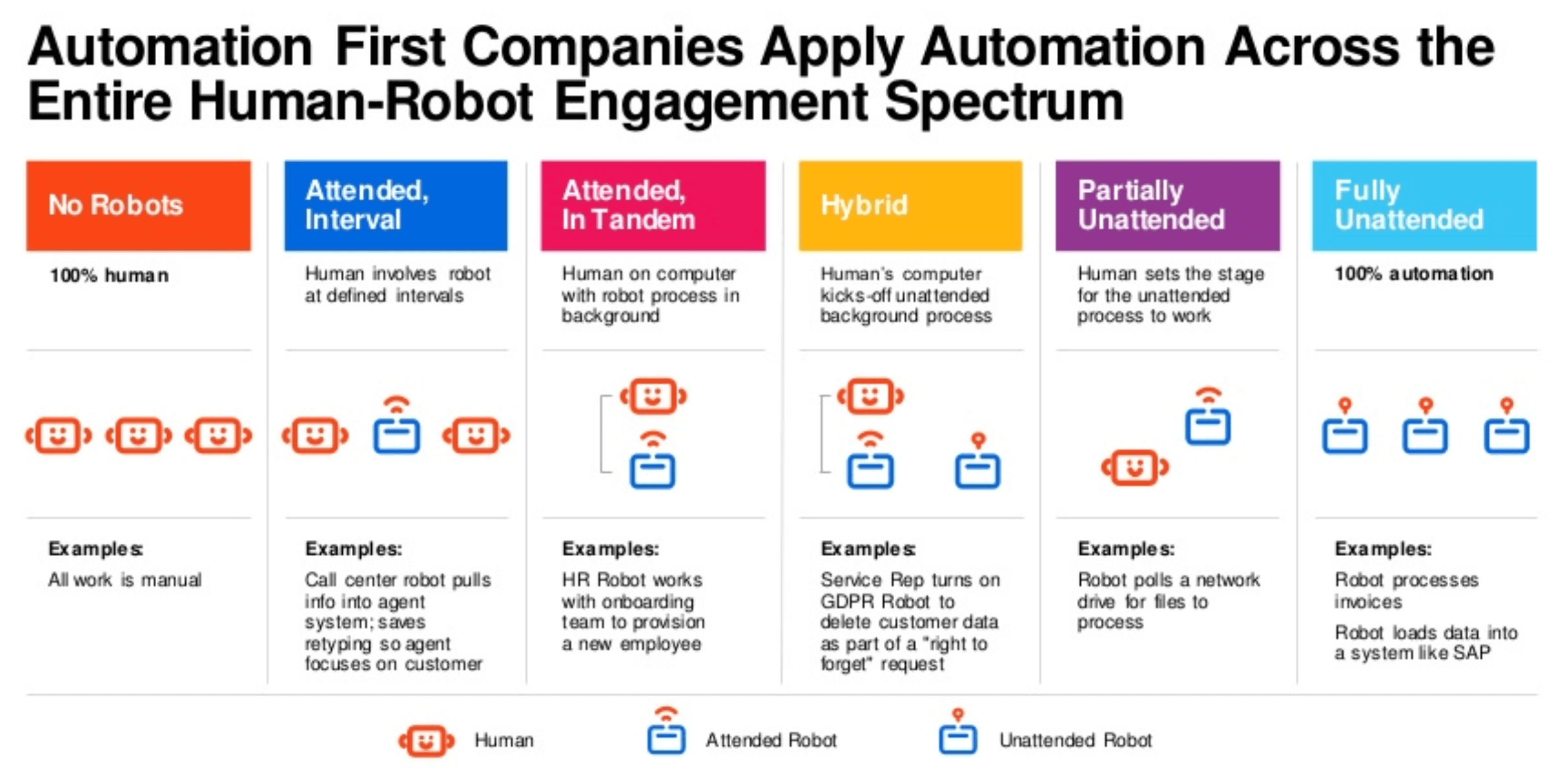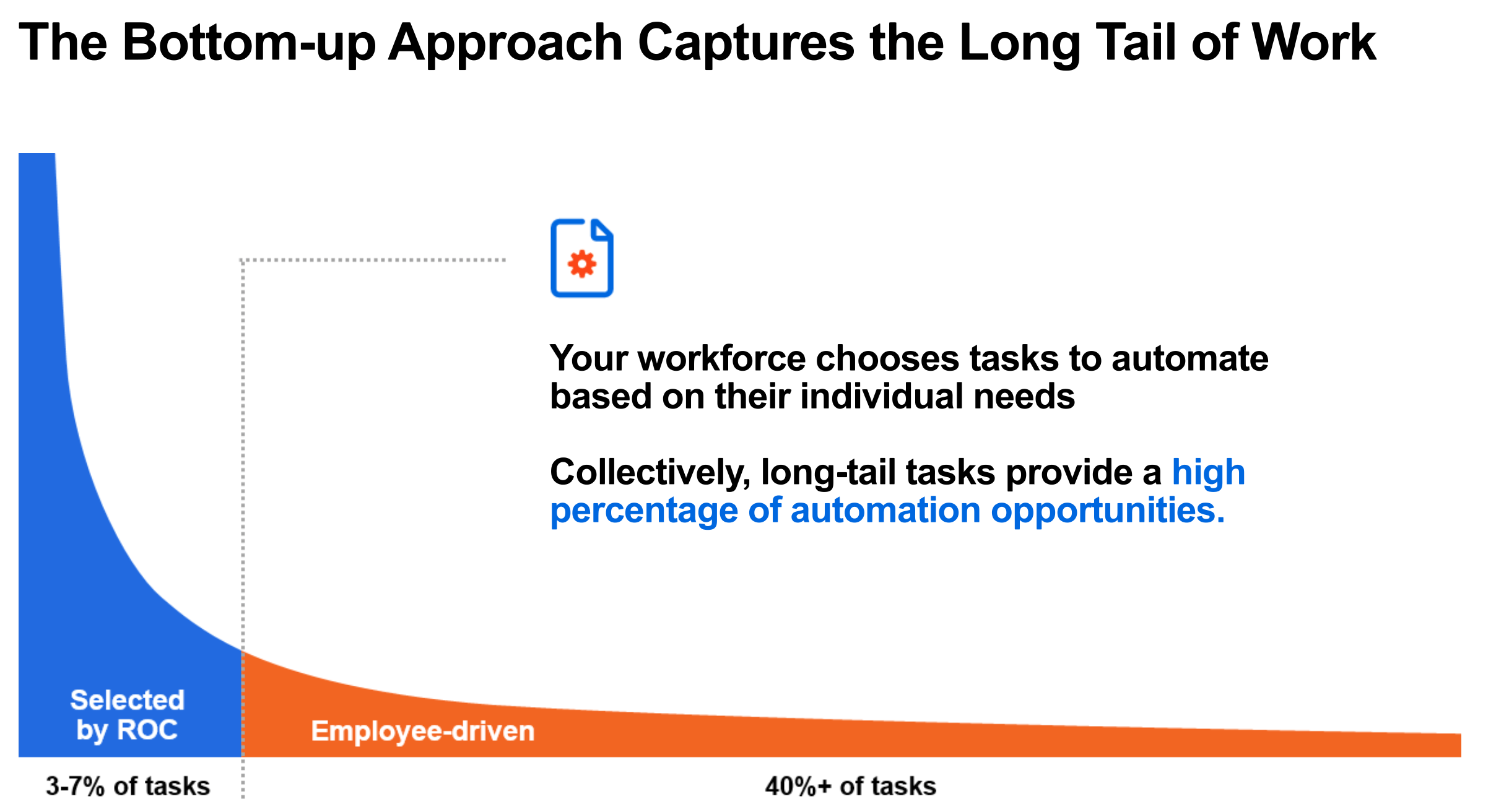What Does It Mean to Think with an Automation First Mindset?
Share at:

An ‘automation first’ organization has a different set of principles than traditional organizations.
When there's a new problem, they don't think about how humans or software can address it but how a hybrid workforce can best solve it.
With robotic process automation (RPA), software robots can automate all or part of the necessary processes and ensure that the repetitive portions of these processes don't monopolize employees’ valuable time and creative energies. This entails a transformation in your company’s vision of the future and your strategies for getting there.
We call this transformation the automation first mindset. It’s an essential part of thriving in the automation first era and pursuing a vision of the future of work that prioritizes human engagement and creativity without sacrificing the bottom line.
Beyond deciding to deploy RPA, this mindset is foundational for your ability to achieve lasting digital transformation and remain adaptable in the face of disruption.
To think automation first:
Focus on outcomes
Automate everything that makes sense
Establish systems that support this mindset shift and empower employees to drive automation ideas
Shift to an outcomes-oriented perspective
At UiPath, we refer to the automation first era as an era because it will introduce an unrivaled amount of innovation compared to previous era-defining changes, such as the Industrial Revolution and disruptions from mobile and cloud computing technologies.
As in previous eras of disruption, businesses are discovering that good enough isn’t good enough in the automation first era.
An automation first mindset means you are working backward from desired business outcomes to construct the hybrid workforce to get you there. This frees you to use software robots or humans wherever they fit best.
Join me and Emily Wasik, Thought Leadership Editor at the Economist, for a webinar packed with insights on how leading businesses are using this mindset to win in their markets
When a process requires repetitive, tedious work, you know there are robots ready to scale to whatever level of processing power you need. As such, you know that you have humans ready to solve problems that humans are better at, like abstract thinking and creativity, because they’re not mired in repetitive, manual work.

Source: Welcome to the Automation First Era: Your Guide to a Thriving Enterprise
An automation first organization embraces the fact that the future of work will require most, if not all, of the traditional ways of completing processes to change to some degree. For some processes, that’ll mean unattended robots taking over; for others, that’ll mean attended robots helping employees in real-time.
Robots are scalable in a way humans aren’t. Rather than go on a hiring spree or asking current employees to work harder, organizations can deploy software robots to ensure processes run faster and better—all without causing undue strain on employees or slowing down the company.
Robots and humans are best together. An organization with an automation first mindset builds its problem-solving philosophy from that knowledge.
Embrace every opportunity for automation
One of the primary rules an automation first company lives by is this: If it’s possible to automate, you should.
Making this rule a reality requires organizations to develop processes that identify, rank, and test automation opportunities.
The most effective way to implement automation is through the use of a robotic Center of Excellence (CoE).
A CoE is a centralized unit that handles the deployment of robots throughout the organization. This team centralizes all the governance policies and best practices, so an automation first organization can scale robot deployment without sacrificing quality.
The CoE, with input from relevant parties and departments, can then rank tasks by their volume and the time they consume. Costly tasks done the most often will offer the largest ROI once automated.
You can measure RPA and its benefits in a variety of ways, but the CoE has an important role in tying each metric back to higher goals, such as increased productivity and more engaged employees.
At specialty chemical company Clariant, for instance, simple shipment notifications, delayed by data entry and verification, left stakeholders waiting on important updates that needed up-to-the-minute reactions. With robots automating parts of these processes, they were able to end delays and keep everyone informed.
Clariant now processes 2,500 invoices each month by robots. By removing the manual elements of coordinating shipping documents, they’ve also saved 40,000 printouts every quarter.
Enable the long tail of automation
An automation mindset isn’t only held by executives or RPA developers. Every employee will be able to consider automation an everyday tool.
Automation leaders can identify a few processes that yield the biggest returns once automated, but only your employees can identify the small, daily challenges that make their workflows less efficient than they could be.
When the returns on small improvements can rival the automation of larger, more monolithic processes we call this the long tail of automation.

Source: Welcome to the Automation First Era: Your guide to a thriving enterprise in an automated world
Large, institutional automations—like using software robots to process the thousands of invoices your company sends every month—exist in your automation short tail. These are the kinds of processes your CoE prioritizes: high volume, high cost, and high ROI once automated.
A vaster variety of opportunities for automation exist in the long tail, but only your employees can identify them.
At UiPath, we use the long tail as a metaphor for employee-led automation. Automation first companies have set their sights on providing a robot for every person. This will allow them to empower employees to see problems as problems-to-be-solved and pursue ever-smaller pain points, aggregating those solutions into massive returns.
The long tail lengthens even more once you consider the effects these automations have on your workforce.
McKinsey & Company estimates that existing technology can automate 45% of the activities organizations pay employees to do. Imagine what your employees can do once freed from this work.
The proportion of automated work will only increase as RPA technology continues its rapid pace of evolution.
Dive deeper: The 4 Pillars of a Fully Automated Enterprise™
Already, we’re seeing machine learning technologies that enable employees to make more informed decisions backed by robots that can gather more data, ready it faster, and verify and analyze it better than humans could before.
The future of work lies in making this technology accessible to each employee, allowing them to automate their day-to-day tasks. While this goes against the grain of focusing automation on high-volume, ‘low-hanging fruit’ processes, an automation strategy creates better productivity and efficiency returns into the future.
The future of work requires an RPA solution that every employee can use to automate entire processes, supporting elements of everyday work, or help somewhere between.
How to support an automation first mindset
An automation first mindset depends as much on the organizational structure as it does on new beliefs.
That’s why 80% of automation first organizations report automation as a C-level responsibility, according to The Economist. When the C-suite considers automation, they drive the vision and strategy of the company forward.
As such, executives have a series of automation goals and an agenda for when they want to achieve them. This is more practical if your organization also has a chief digital officer or a chief automation officer role.
By this point, your CoE is also fully functional. The automation pipeline that flows through it should be robust, and the CoE should be implementing top-down and bottom-up automations.
Initial automation deployment starts for the sake of productivity benefits, but in an automation first organization, those goals will shift further toward the future.
Improving operational efficiency and employee experience will become parallel goals.
As robots become part of the normal toolset, they’ll also become part of staffing expectations. The recruiting and onboarding processes will focus on the work new employees will be doing with robots.
New employees will know from the get-go that they’ll be joining a hybrid workforce and that they’ll have robots at their disposal to keep work efficient.
The automation first mindset—with the right infrastructure, support, and organizational structure—will diffuse throughout your company. Once empowered and trained, citizen developers will be able to identify and automate tasks on their own.
An automation first mindset doesn’t prepare your organization for the future of work but enables you to lead your organization toward it.
Automation is more than a business solution
The full benefits of automation go beyond solving business problems.
Thinking automation first enables you to think and act faster than your competitors, ensuring you can react to technology and business changes to develop new ways to serve your customers before others can. Disruption is a constant threat; companies that can’t adapt will fall behind.
Getting up to speed isn’t about solving business problems or even about solving business problems faster—it’s about transforming in such a way that the experiences of your customers and your employees are closer to the heart of your company’s operations.
An automation first mindset prioritizes the use of robots, but the ultimate goal is to better focus on the needs and unique capabilities of humans. The future of work will involve more changes than anyone can predict.
To learn more, get your complimentary copy of our report "Welcome to Automation First Era: Your guide to a thriving enterprise in an automated world"

Chief Marketing Officer (CMO), Ada
Get articles from automation experts in your inbox
SubscribeGet articles from automation experts in your inbox
Sign up today and we'll email you the newest articles every week.
Thank you for subscribing!
Thank you for subscribing! Each week, we'll send the best automation blog posts straight to your inbox.



